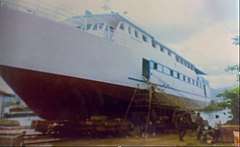Sinking of MV Wahai Star
The sinking of MV Wahai Star occurred on the night of 10 July 2007, when a speedboat tugged by the ferry accidentally crashed into its stern, resulting in a major leak. In the following days, rescuers managed to save 43 people, while 16 bodies were recovered in the nearby waters.[1]
 Photograph of MV Wahai Star (taken from NTSC final report) | |
| Date | 10 July 2007 |
|---|---|
| Time | 20:00 - 22:00 (UTC+9) |
| Location | 8-9 miles off the coast of Ambon Island, Maluku, Indonesia |
| Coordinates | 03°42′00″S 127°07′00″E |
| Cause |
|
| Outcome |
|
| Deaths | 16 confirmed |
| Missing | Unknown |
| Passengers and crews | Unknown (around 60-70) |
| Survivors | 43 |
The investigation conducted by the Indonesian National Transportation Safety Committee concluded that the main cause of the accident was the crew's decision to continue to Ambon despite deteriorating weather conditions. While it was en route to Ambon, the speedboat that the ferry was tugging suddenly struck the stern of the ferry. After failing to stop the resulting leak, the Captain instructed the passengers and crews to abandon the ferry.[1]
Sinking
MV Wahai Star departed Namrole Harbour on Buru Island at 09.00 a.m local time. A speedboat, which was used to carry the passengers to the ferry, was tugged along the route. At 20:00 p.m local time, as it was travelling to Ambon, weather conditions began to deteriorate. Heavy winds blew from the southeast and waves reaching 3 meters in height struck the ferry.[1]
Crew members suddenly heard a loud impact on the stern of the ferry. A quick examination revealed that the impact was caused by the tugged speedboat. The force of the impact caused a leak in the engine compartment. Crew members tried to pump the water out of the ferry, but were forced to use buckets instead due to the sub-optimal functioning of the pump.[1]
At 21:30 p.m, the Captain of MV Wahai Star ordered the crew members to distribute life-jackets to the passengers and to issue a distress call to local authorities. This distress call was not replied to. All attempts to drain the water proved unsuccessful and the engine compartment flooded, causing the lighting of the ferry to fail.[1]
The ferry was repeatedly struck by waves reaching 3–4 meters high, causing the ferry to lose its stability. It began to list to its port side. At 22:00 p.m, the Captain ordered all passengers and crew to abandon the ferry.[1]
Search and rescue
The vessel that managed to reach the site first was a tanker ship that was passing by. Several hours after the sinking, rescuers managed to save 23 passengers from the sea. They were taken to Ambon, the provincial capital of Maluku. 2 bodies were also recovered. The rescue effort was hampered by bad weather.[2][3]
On 14 July, as many as 5 ships were deployed. The death toll then rose to 15 as more bodies were recovered. An additional 2 survivors were found.[4]
In total, rescuers managed to save 43 people, while 16 bodies were recovered. Another 15 people were declared as missing and presumed dead.[1]
Passengers and crews
There were conflicting reports on the number of passengers and crew on board. Initially, between 60-100 people were reported to be on board. It was later revised to 60. The administrator of the local harbour stated that a total of 42 people were on the ferry. However, the search and rescue team reported that more than 61 people, including those who died in the sinking, had been evacuated from the sea. The final report, published by the NTSC, indicated that there were more than 60 passengers and crew on board, but did not specify an exact number.[1][5]
Investigation
Prior to the ferry's departure, ground officials had issued warnings not to travel to the waters around Ambon Island due to the deteriorating weather conditions. Officials suspected that the crew of the ferry ignored the warnings.[5]
The official final report finally concluded that the sinking was caused by the high waves that had been produced by the adverse weather conditions in the area. The high waves moved the tugged speedboat to the stern of the ferry, causing a powerful impact. The impact was powerful enough to cause a leak. Because the draining efforts were unsuccessful, the ferry flooded and capsized.[1]
See also
- Sinking of MV Dumai Express 10, a ferry sinking with a similar cause
References
- "Final Report" (PDF). National Transportation Safety Committee.
- "Kapal tenggelam di Maluku" (in Indonesian). BBC Indonesia. 11 July 2007. Retrieved 15 February 2019.
- "KM Wahai Star Tenggelam, Bangkai Kapal Belum Ditemukan". Detik (in Indonesian). 11 July 2007. Retrieved 15 February 2019.
- "Korban Tewas KM Wahai Star Jadi 15 Orang". Detik (in Indonesian). 14 July 2007. Retrieved 15 February 2019.
- "Dephub: KM Wahai Star Tenggelam karena Cuaca Buruk". Detik (in Indonesian). 16 July 2007. Retrieved 16 February 2019.